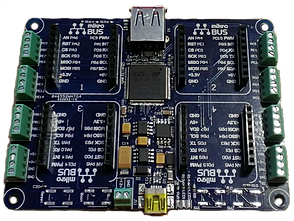Previously my pinouts were this:
- 3v3
- 5v
- GPIO
- Analog
- GIO
- Ground
I came up with this pinout based on the MaxBotix so that one may be able to connect the sensors so that one can trigger the next one. The trigger-out from sensor #1 would go to the trigger-in to sensor #2.
But I was think that many devices use the SPI (wiki definition) protocol and it wouldn't work with my own spec. That needs Clock, Select, DataIn, DataOut pins, 1 more than what I have available. However, if I remove one of the power lines, then I would have 4 lines for data.
So going forward I'm going to only supply 5v to the my boards. If the sensor or breakout board needs only 3v3, then I can use a voltage divider or a regulator to bring down the voltage.
New pinout:
- 3v3
- GPIO
- GPIO
- Analog
- GIO
- Ground
- Gadgeteer has a 10 pin connector protocol, with 3v3, 5v and GND being standard places
- MikroElectronics has a connector with standardized pinouts for several protocols
- Arduino has standardized pinouts on the connectors for the mCu breakouts.








